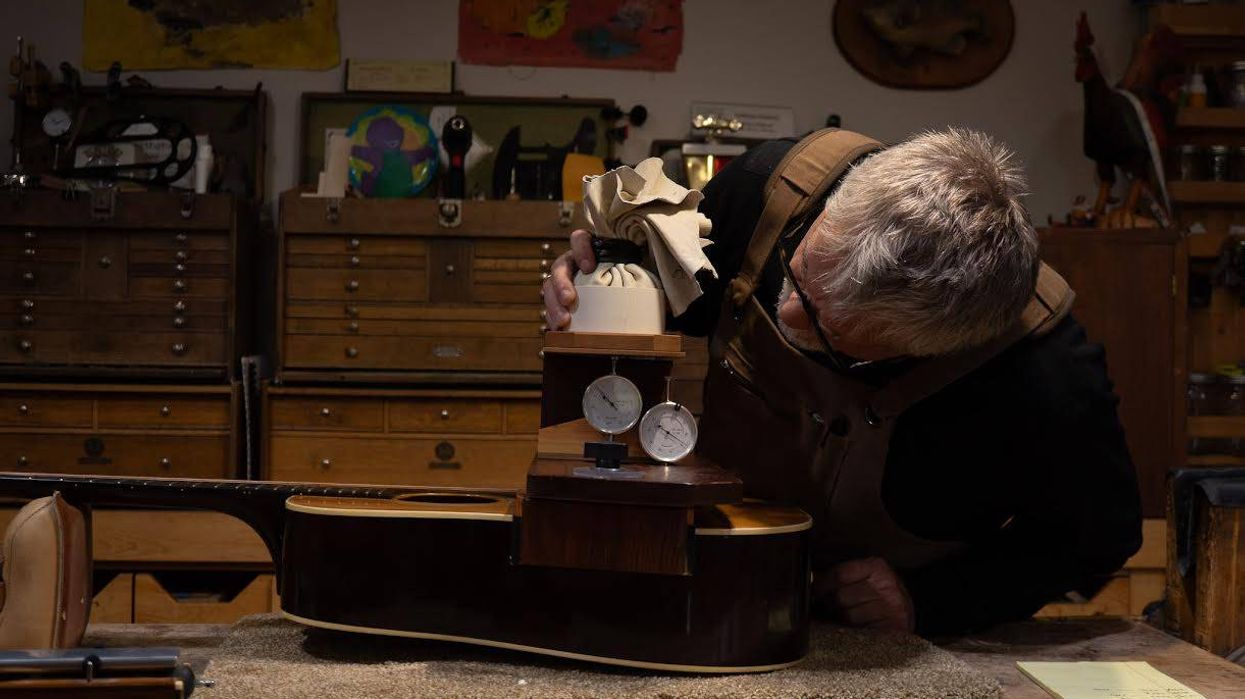Small guitars weren’t considered a big deal 25 years ago, but whether you label them as baby, parlor, piccolo, travel, or kids’ models, undersized guitars have been the fastest-growing segment of the acoustic guitar market in the new century. It’s not that “big” guitars don’t sell anymore, and you’re certainly not going to see anybody strapping on a baby or parlor model when fronting a bluegrass band, but what happened?
Some attribute the new popularity of little guitars to specific artists, such as Ed Sheeran and his preference for pint-sized Martin LX1E models. And let’s not forget about Canadian astronaut Chris Hadfield, who became a YouTube sensation by singing David Bowie’s “Space Oddity” with a Larrivée parlor in hand—while floating in space. But even before such high-profile appearances, small guitars had been growing in popularity as players got tired of lugging around heavy cases just to take a guitar lesson or work out a new tune during their lunch break. Whether you like to play sitting up in bed or in the back seat of your car, bigger isn’t always better. And when traveling, of course, too often it’s a choice between bringing a quite small guitar or not bringing one at all.
Grand concert-size acoustics have long been the default choice for a small guitar, but these classical-sized steel strings, usually a bit over 14" wide in the lower bout, still left room for improvement if you wanted to get close and comfy with your instrument. For one thing, the typical 00 or GC model has a string scale just under 25", which meant that with a 14-fret neck, a player’s fretting hand is still a long way from his or her lap when playing in first position. To be both more portable and more comfortable when played sitting in a scrunched position, a very small body with a full-sized neck just isn’t as effective a design.
Although small guitars had been around for years, the number of new entries in the field really heated up in the early 1990s. One of the first steel-strings marketed with the word “parlor” was the Larrivée P model, which featured 12 frets clear of the body and a 24" string scale. With its short neck and small body, it was a very cuddle-friendly design. Martin won the how-small-can-you-make-it contest with their Backpacker model—which really could fit in a backpack—but for everyday use and travel that didn’t include hiking trails, many players opted for something larger that delivered more guitar-like tone. Taylor’s Baby models, introduced in 1996 and pictured on the Taylor catalog cover with infants in diapers, were initially pitched as guitars for children. Most Taylor dealers, however, found that customers more often used their kids as an excuse to buy a handy little guitar for themselves.
Soon it was clear that many guitarists wanted more deluxe woods and appointments in a very small instrument. Music industry insiders scoffed at the idea that players would pay premium prices for a guitar not much bigger than a baritone uke, but were proven wrong when Collings began offering a Baby model in 1994 that sold for the same price as a full-sized guitar of the same style. The success of the late Bill Collings’ Baby proved what vintage-guitar fans had known all along: A lightly built little steel-string acoustic can sound very much like a full-sized guitar, but with the volume turned down a couple of notches. Another revelation was that people devoted to the guitar are always ready to embrace a new type of guitar that expands their ability to enjoy playing. And those accustomed to top-shelf instruments won’t flinch at paying for the same quality in a much smaller format.
It’s not surprising that small-production workshops looked to expand sales by offering very small models, and there are enough little guitars on the market now to offer players a wide selection. These small guitars vary much more than standard sizes because the guitar builders aren’t all following the same playbook. Line up a half-dozen rosewood OMs by different makers, and the differences in tone are subtle since all the instruments are the same size and shape. But try the same with a Wee Lowden, Santa Cruz Firefly, Collings Parlor, and a Bourgeois Piccolo, and the tone and feel of each is distinctly different. That’s because nearly all those four guitars have in common is that they’re small.
Acoustic stalwarts Martin and Taylor have continued to fuel the small-guitars revolution with models slightly larger than their aforementioned pocket-sized examples from the early ’90s. And compared to a full-sized acoustic, these models offer better tone and volume while still being far more portable when stuffed in a gig bag. Martin’s D Jr. is an 0-size dreadnought model, but with a much shorter string scale, while Taylor’s GS Mini (as the name suggests) looks like a very small jumbo. Thanks to modern pickup technology, such “bigger than too little” acoustics offer a very credible plugged-in tone that expands their useful range.
Considering all the options now available, the question becomes not just when you need a guitar, but given the time and place and how you get there, how much guitar do you really need?



















